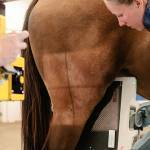Measuring Bone Mineral Content in Horses Using Digital X-rays

How do scientists measure the bone mineral content of live horses during research trials?
In the past, radiographs of the third metacarpal, or forecannon, bone have been compared with radiographic bone aluminum equivalents (RBAE) in which a step wedge acts as the standard curve. Once validated for horses, this process, known as radiographic photodensitometry, allowed researchers to record changes in bone mineral content during nutrition and exercise studies.
With the onset of digital radiography, researchers ran into an unanticipated roadblock with RBAE measurements; the problem had not cropped up when film was used. When using digital radiography, raw or unprocessed data is processed after acquisition. Processing algorithms are generally proprietary and specific to vendors of digital equipment, but they encompass manipulations to optimize image quality. These processing steps have a profound effect on the final appearance of the radiograph, and they can also lead to artifacts unique to digital systems that affect density measurements.Researchers at Michigan State University recently confirmed that the use of unprocessed digital radiography images allows for accurate evaluation of bone mineral content and certain bone morphological measurements.*
Using cadaveric forecannon bones from six mature euthanized horses, researchers shot digital radiographs from two different views, dorsal-palmar and lateral-medial. An 11-step aluminum step wedge penetrometer was placed on the radiographic cassette in every image. Researchers removed processing algorithms from the images, ending up with two versions of every radiograph—one processed, one unprocessed.
Cortical width, bone diameter, and medullary cavity diameter were assessed on the unprocessed digital radiographs, and cortical RBAE was measured in both processed and unprocessed digital radiographs using the step wedge for comparison. The bones were then measured by hand using digital-display calipers. Bone ash was obtained from each bone and processed to determine bone mineral content.
According to the researchers, the “physical and digital measurements of dorsal, medial, and lateral cortices, as well as dorsal-palmar outer diameter, tended to be similar but palmar cortex measurements did not. Total RBAE was strongly correlated to bone mineral content.” Therefore, these results “suggest that using digital radiographs to make morphological measurements is accurate and confirms the strong relationship between total RBAE and bone ash.”
This research underscores the importance of using unprocessed images, a finding that corroborates a study at Kentucky Equine Research. In an abstract published in 2017, those researchers summarized their findings this way: “RBAE values obtained from unprocessed images were similar to values measured in previous Kentucky Equine Research studies using analog film radiography. Raw (unprocessed) images should be used with digital radiography systems to determine RBAE in equine bone.”**
A well-balanced diet is the jumping-point for skeletal health. To maximize bone support, especially during periods of stall rest or other long stretches of no turnout, consider a research-proven supplement like DuraPlex, a proprietary blend of specific proteins, minerals and vitamins scientifically proven to increase bone mineral density and bone area. (In Australia, look for Bone Food Plus.)
“Bone demineralization can begin to occur in stall-rested horses after just a few weeks of inactivity, so it’s important to consider targeted nutritional supplementation,” explained Catherine Whitehouse, M.S., a nutritionist at Kentucky Equine Research. “Studies showed positive changes in bone quality after 30 days of supplementation with DuraPlex.”
Another product, also developed by Kentucky Equine Research, that would be appropriate for horses on long-term stall rest is Triacton. In addition to its bone-health benefits, Triacton contains buffering agents advantageous for gastric and hindgut health.
*Emmert, B.J., C.I. Robison, A. Pritchard, and B.D. Nielsen. 2022. Comparison of bone mineral content of the equine third metacarpal to total radiographic bone aluminum equivalents from unprocessed digital radiographs. Journal of Equine Veterinary Science 110:103837.
**Pagan, J.D., P. Kazakevicius, A. Swanhall, E. Ford, and A. Pritchard. 2017. Comparison of processed and unprocessed digital images for the determination of radiographic bone aluminum equivalent (RBAE) values in equine bone. Journal of Equine Veterinary Science 52:49-63.








